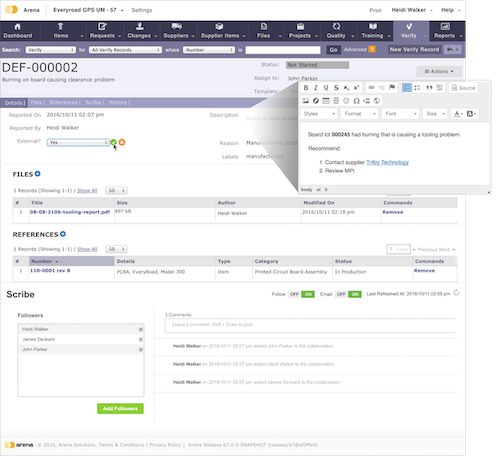
Arena Verify adds requirements and defect tracking to create a holistic product development platform. Image Courtesy of Arena Solutions
Latest News
November 22, 2016
In response to increasing product complexity, in part driven by the Internet of Things (IoT), Arena Solutions has expanded its cloud PLM platform with new requirements and defect tracking capabilities, attempting to create what it calls a holistic product development platform.
The latest 2016 Fall release of Arena now includes Verify, an application lifecycle management (ALM) module that ties defect and requirements management information to the main product record, affording stakeholders across different functional areas with access to the same information. The Arena PLM has long had a robust quality management system for handling common product quality business processes, including 21 CRF Part 11 and 21, complaints, and corrective action preventive action requests (CAPAs). Verify expands that set of functionality with capabilities more typically associated with software quality efforts, explains Kent Killmer, Arena’s vice president of Marketing.
 Arena Verify adds requirements and defect tracking to create a holistic product development platform. Image Courtesy of Arena Solutions
Arena Verify adds requirements and defect tracking to create a holistic product development platform. Image Courtesy of Arena Solutions“We’ve taken some of the hottest ingredients of ALM and conjoined them with PLM and QMS,” he says, specifically referencing the module’s issue management, bug management, defect management and requirements capabilities. Typically, those functions have been handled in one system with QMS workflows tracked in another system, and rarely, if ever, the two shall meet, he maintains.
“Verify will talk to all engineers—mechanical, electrical, software and firmware and keep everyone in the know,” he says. “Not only are we breaking down silos, we allow users to have a single view with one user interface versus having to log in to multiple, disparate systems that are bandaged together.”
Extending PLM to the Shopfloor
In related news, Arena announced a partnership with 1factory to extend PLM-centric quality control to the factory floor and across the extended supply chain. Ifactory handles inspection and test planning, digitizes production floor measurement data, enables traceability, and serves up real-time analysis to minimize defects and bolster process improvement, officials say. The integration connects the product information in Arena with the quality control data in ifactory. In this way, if a part or assembly fails inspection, for example, an Arena quality object (a supplier corrective action or CAPA) can be created directly from within ifactory, and engineering teams and suppliers can collaborate on an action plan using the same information.
Unifying all quality initiatives under a common platform and UI is essential in the age of IoT, when previously simple mechanical products are re-envisioned with complex electronic components. “If you don’t have a single view, there is going to be break downs and duplication of data,” Killmer explains. “This is a closed loop approach that sorts it all out and lets people upstream and downstream have all the information they need to facilitate better outcomes.”
Watch this video to get more details on the Arena Fall 2016 release and Verify.
Subscribe to our FREE magazine, FREE email newsletters or both!
Latest News
About the Author
Beth Stackpole is a contributing editor to Digital Engineering. Send e-mail about this article to [email protected].
Follow DE





